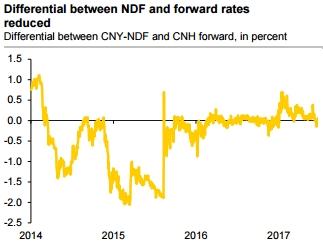China's yuan softened against the U.S. dollar on Friday and is set for its worst week in more than three months, dampened by weaker guidance and rising corporate demand for the greenback. In late May, the Chinese authorities let the yuan appreciate by more than 1 percent, a sizable leap for a currency that normally trades within a wafer-thin range and shed 6.5 percent to the dollar last year, as per the NASDAQ.
On the pursuit of optimal hedging, one may be tending to simply choose the tool that is cheaper. Even though the differences in the quoted prices between CNY-NDFs and CNH forwards have fallen notably since the PBoC started relying more on market forces in August 2015 (refer above chart) there are still price differences in 2017. In January these reached 0.7%.
Usually, the IVs (implied volatilities) in CNH is meager, but the economic difficulties in China but also the surprising institutional changes (e.g. to the fixing process) suggest that higher CNY volatility is likely to be the norm in the future.
Economize on premium-spend on carry trades using ratio call spreads that generate comparable returns to standard ATMF/ATMS option spreads but with lower premium outlay. USD put/Asia FX call ratios are well priced currently, with USDCNH the favored pick. However, if you’re skeptic on USDCNH vols (long option position needs higher IVs for significant change in Vega), alternatively, one can prefer other derivatives (preferably forwards).
However, a decision between these two tools should not be based exclusively on current price levels as a peculiarity of CNY-NDFs has to be taken into consideration: Usually, CNYNDFs are settled on the basis of the PBoC fixing, even though this approach is actually based on a misunderstanding. Even if everyone calls the PBoC’s quotation “fixing“ that is not what it is. A fixing would be a determination of the market rate (and would, therefore, be close to the spot rate).
Instead, the PBoC sets the mean of the acceptable USD-CNY fluctuation range on a daily basis - and following the recent introduction of a “counter-cyclical adjustment factor” completely at will. This mean rate is called “fixing” and is used to settle the NDF. Since 17.3.2014 the permissible fluctuation range by which the market rate can differ from the fixing is ±2%, so quite considerable.
Exemplary calculation: A USD-based importer who wanted to hedge receivables worth CNY 1m payable in two months’ time on 29th March 2017 (settlement date 31st May 2017) would have chosen a CNY-NDF at a rate of 6.8375 had he based his choice on the price levels at the time. Initially, that would have been USD 560 cheaper than hedging with CNH forwards (6.8114 at the time).



 Inflation: why prices look likely to stay high in the UK and Ireland, and what that means for mortgages
Inflation: why prices look likely to stay high in the UK and Ireland, and what that means for mortgages  The Federal Reserve held off hiking interest rates
The Federal Reserve held off hiking interest rates  Interest rates: Monetary policy is always political as central banks opt to back the financial sector
Interest rates: Monetary policy is always political as central banks opt to back the financial sector  The Federal Reserve and the art of navigating a soft landing ... when economic data sends mixed signals
The Federal Reserve and the art of navigating a soft landing ... when economic data sends mixed signals  FxWirePro- Gold Daily Outlook
FxWirePro- Gold Daily Outlook  A new wave of wearable devices will collect a mountain on information on us
A new wave of wearable devices will collect a mountain on information on us  Is attachment theory actually important for romantic relationships?
Is attachment theory actually important for romantic relationships?  Sure, the RBA froze interest rates on Tuesday, but there's plenty of pain to come
Sure, the RBA froze interest rates on Tuesday, but there's plenty of pain to come 





























